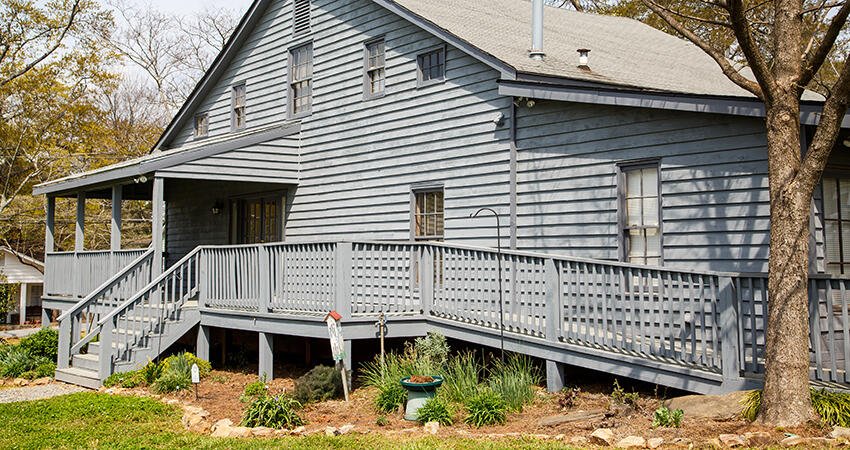
(Darryl Brooks / Shutterstock)
Home Modifications Can Improve Health Outcomes for Urban and Rural Veterans
- Title:
-
Home Modification and Health Services Utilization by Rural and Urban Veterans with Disabilities
- Author:
-
Luz Mairena Semeah, Shanti P. Ganesh, Xinping Wang, Diane C. Cowper Ripley, Zaccheus James Ahonle, Mi Jung Lee, Tatiana Orozco, Jennifer Hale-Gallardo, and Huanguang Jia
- Source:
- Publication Date:
Nearly one-third of veterans report having a disability, and not all live in accessible homes. Veterans living in rural areas face even greater challenges accessing medical care because of commuting (distance travel/time, spatial) barriers and availability of providers or specialized health services. In rural areas, 63 percent of dwellings are substandard, meaning they require alteration or repairs to improve accessibility and address faulty plumbing or kitchens. For more than four decades, the Veterans Health Administration (VHA) has provided home modification services for veterans with disabilities through the Home Improvements and Structural Alterations (HISA) program. HISA primarily funds home alteration to improve safety and accessibility in the home and the provision of health services. To understand the impact of HISA-funded home modifications, this study examined the differences in hospitalizations and outpatient encounters between urban and rural veterans 12 months before and 12 months after HISA use.
Drawing on data from the National Prosthetics Patient Database, the VHA Patient Treatment Main File, and the VHA Outpatient Encounter File, researchers analyzed a national database of all VHA-enrolled veterans who were diagnosed with a disability, had a home modification prescription from their VHA provider, and had a HISA-funded home modification completed between fiscal years 2011 and 2016. The study tracked 29,910 eligible veterans (20,000 urban and 9,910 rural residents) for 12 months before and after their home modification to understand how the home improvements influenced their likelihood to visit an outpatient clinic and/or be hospitalized and how those trends varied across urban and rural veterans. They also analyzed sociodemographic and clinical factors, including age, race, sex, comorbidities, marital status, and primary medical diagnoses. Across the sample, the mean age was 72.5 years old, 95.6 percent of the veterans were male, 70.5 percent were white, 18.6 were Black, 77.5 percent were married, and the most common primary medical diagnoses were musculoskeletal and neurologic.
The findings suggest that veterans using the HISA program may be more likely to engage in preventative and health maintenance care and are less likely to suffer the adverse effects of emergent hospitalization relative to those not using the program.
Key findings
- For both rural and urban veterans, there was a statistically significant reduction in hospitalizations in the 12 months following the home modification compared with 12 months before the home modification. Overall, the rate of hospitalizations decreased from 66.1 percent to 59.5 percent across the sample. This shows the importance of HISA-funded home modification in improving veterans’ mental and physical health, both of which are important for better quality of life.
- For both rural and urban veterans, there was a statistically significant increase in outpatient encounters in the 12 months following the home modification compared with the 12 months before. Overall, the rate of outpatient encounters increased from 87.2 percent to 92.5 percent.
- A veterans’ rural or urban status was not significantly associated with hospitalization either 12 months before or after a home modification. For outpatient encounters, veterans in urban areas were significantly less likely to visit an outpatient clinic than their rural counterparts during the 12 months before their home modification, but no significant differences were found during the 12 months after.
- For female veterans and Black veterans, there was a significantly increased likelihood of outpatient encounters in the 12 months after their home modification. These findings may indicate increased access to care once diverse groups are more integrated into the VHA system.
- Before and after a home modification, being unmarried was associated with an increased hospitalization rate. This might be because marriage can be considered a type of protective social support.
- Increased comorbidities were associated with higher hospitalization rates both before and after a home modification.
- Aging by one year was slightly associated with fewer hospitalization and outpatient encounters, possibly suggesting a bias from healthy survivors.
Policy implication
- According to the authors, these findings suggest that increasing the provision of funding for home modification services such as HISA could free up hospital beds, reduce costs to both individuals and institutions, decrease the risk of hospital-acquired morbidity and mortality, and promote independent living and consistent community integration.


